Last weekend, I had one major goal—to make my own sourdough bread from scratch. And I did it! I’m not going to lie, it takes a LONG time to make. It’s not something I would do every weekend. But the results were delicious.

Here are the details on my sourdough bread making experience.
Sourdough starter
The starter I used was Carl Griffith’s 1847 Oregon Trail Sourdough starter—you can get it for free from Carl’s website. It came dried in an envelope, and I revived it used the instructions on the website. The most essential part is the following:
Get a small container. Begin with one tablespoon of lukewarm water, stir
in 1/2 teaspoon of your starter and let stand for a few minutes to soften
the start granules. Then mix in one tablespoon of flour. Depending on the
flour, you may need to add an additional teaspoon or two of water. You want
the mixture to be like a thin pancake batter. When the mixture gets
bubbly, put it in a little larger container. Then stir in 1/4 cup of water
and 1/4 cup of flour. When that mix rises up add 1/2 cup of water and 1/2
cup of flour. When this bubbles up, you will have about one cup of very
active starter that is ready for use or storage in your refrigerator.
I mixed it in glass jar with a plastic spoon. When I did, it looked like this:

Those spots are bubbles, and they’re a sign that the starter is active. I have to admit something here—using just water and flour didn’t give me bubbles. But I read in the Carl’s brochure that a little vinegar would kick the starter into high gear. After reading that, I realized it would probably be a good idea for me, since my tap water is both hard and alkaline, two aspects that starters don’t respond well to. A small amount of apple cider vinegar did the trick. I used anywhere from a few drops to 1/4 tsp depending on how much water I was adding, and I did this every time I added water to the recipe too.
The recipe
For my first attempt at sourdough, I chose a recipe from Carl’s website called Simple Sourdough Pan Bread, Hand Mixed with a Low Knead Procedure. It’s the second on the list in the above link (PDF here). I chose it because it really did seem straightforward: four ingredients, two bread pans, and only a little kneading. I wouldn’t recommend making sourdough bread if you’ve never made bread before in your life, because many things are left to the baker’s judgement in this and other recipes. But you don’t need to be pro to do this either. I’d recommend baking some other bread first if you haven’t done so before.
Here’s the ingredient list for the recipe—don’t do what I did and almost run out of flour!
Ingredients
• 1 Cup Active Sourdough Culture
• 2 Cups Water
• 5 to 6 Cups Flour (divided)
• 1 Tablespoon Salt
The directions are rather lengthy at this point, but they are divided into sections, so instead of reprinting them all I am going to just write down the section and what time I started it, with photos.
It took longer than the recipe said because a) it is still cold here, and most of the rises require warmth and b) I have a life and could not always do each step at the exact time. Again, this is a long process—do it on a day where you have lots of random stuff to do around the house (for me, grading papers).
Baking bread, step by step
1. Make the sponge, 1:30am Sat
Before I went to sleep on Friday night, I made the sponge. Unfortunately, I forgot to take a photo of this stage. I remember that it was very bubbly the next morning, but when I mixed it it was the same thin pancake batter consistency of the starter. Recipe says do this 6-10 hours before the next step.
2. Make the dough, 1:15 pm Sat
 I wasn’t exactly sure what they meant by a “medium” dough, but this dough was really sticky, and I read that this is a good sign for sourdough.
I wasn’t exactly sure what they meant by a “medium” dough, but this dough was really sticky, and I read that this is a good sign for sourdough.
3. Knead the dough, 1:45pm
No photos of the action because I was doing this by myself, but I used the technique in this video that I wrote about in my previous post on bread. The difference I noticed with sourdough is that, due to the stickiness, flouring your hands will not keep the dough from sticking to your hands. You either need to wet your hands and keep re-wetting them as you knead, or lightly oil them. I tried both and I prefer oil a little more, but I tried both and either works.
After this it had to rise by 50%, when it looked about like this:

4. Stretch and fold, 4 pm
No modifications to this technique—oiled surface made things go smoothly. After this step though dough needs to rise until it has fully doubled. I had to put it into a bigger bowl. Here’s the before and after fully doubled:

5. Shape the dough, 8:25 pm
Here’s where you divide the dough, let it rest, then put it in loaf pans. My bread pans are two slightly different sizes, which is why they look a little weird.


6. Final rise, 9:30 p.m.
Once the dough rose enough to touch the plastic wrap, I made expansion cuts and put them in plastic grocery bags for the final rise. It sounded weird but it worked well—this photo is from near the end of the final rise:

7. Bake the bread, 1 am Sunday
Finally, the baking part! While the recipe said 40 minutes at 375 degrees F, mine took closer to an hour. I blame the small bread pan and the fact that my oven runs hot, but since I don’t know how hot, I have to cook everything at much lower temps than suggested. But with some watchful baking, I managed to get it to a lovely golden color outside, with lots of awesome little air pockets inside!


8. Eating the bread for breakfast! Sunday…brunch (ok it was after noon)
The best part about the bread, of course, is the taste! This bread has some of that nice sour flavor without being overpowering, and its spongy without being squishy or underdone. Sourdough is probably my favorite bread for toast, so I made toast with our homemade marmalade from Christmas, eggs (one over easy one scrambled cause I broke the yoke…), and tea with milk. It seemed a rather British brunch indeed:

Blue yarn update!
While this post is already quite long enough, I wanted to live up to the title of this blog and post about some knitting.
First, I finally decided what to make with all my blue yarn! I’m making the Wave Cowl by Rebecca Hatcher. And just to prove it’s actually a work in progress, here’s a photo of it on the needles!

(btw, that little spot of green in the corner is the subject of an upcoming gardening post :c)
I am probably going to end up making the Cranberry version of the cowl, with its flare at the bottom. I had been wanting a pattern inspired by either the sea or the sky because that’s what the blues of the yarn remind me of. I also needed something that didn’t require more than 1 skein, and preferably one that could work with small amounts of different hues. The awesome knitters over at Reddit (the knitting subreddit to be specific) suggested an ombre pattern that arranged the yarns from light to to dark. I thought that was the perfect idea! However, as you can see from the photos in my earlier post, I had a large chunk of the yarn that was all the same hue. So two weeks ago, I divided that up into 1/2 oz. parts and attempted to overdye it to varying degrees to get some more color variation. Here’s the result:

I was going to write a post on how the overdying process went, but I think I can sum it up in one sentence: Unless you are desperate, don’t do it. It was a huge pain. Mordanting the yarns again turned their original blue-gray into gray. Then they needed to be in the black bean dye that was quite strong, and they needed to be in there a long time. It smelled much worse than last time. And for all of that, some of them came out with uneven coloring or hardly differentiated. In some good lighting, you can tell the difference, but even then it is subtle:
Those are the same three, in slightly different lighting. Gah, Too much work for such small results. At least I did get some different shades of blue out of it. But the best part was the fact that this time, I rinsed the beans right after soaking them for their dye, then immediately put them in the slow cooker with some chicken broth, canned tomatoes, onions and a bunch of spices. That’s right—this time I made black bean soup! And once the sourdough bread was ready—lets just say it was a tasty combination:

That’s right, I added peas and a lot of sriracha sauce to my soup. Laugh if you want, but it tasted awesome!
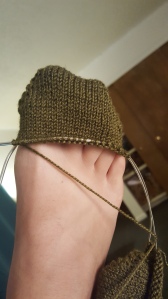 I had started a pair of socks using the free Universal Toe-Up Sock Formula from Knitty, casting on to a very long, size 1 circular needle to knit them both at the same time. I was hoping to use up some forest green wool blend sock yarn I originally intended for another project. But I realized my socks would be quite short with only the green yarn. So I decided to add the blue yarn in as stripes to make them longer.
I had started a pair of socks using the free Universal Toe-Up Sock Formula from Knitty, casting on to a very long, size 1 circular needle to knit them both at the same time. I was hoping to use up some forest green wool blend sock yarn I originally intended for another project. But I realized my socks would be quite short with only the green yarn. So I decided to add the blue yarn in as stripes to make them longer.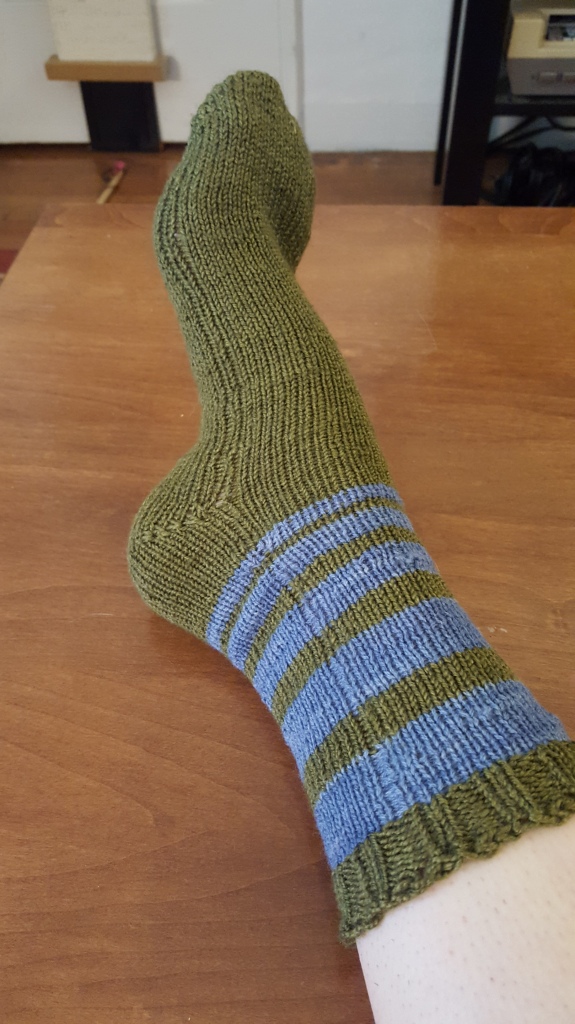
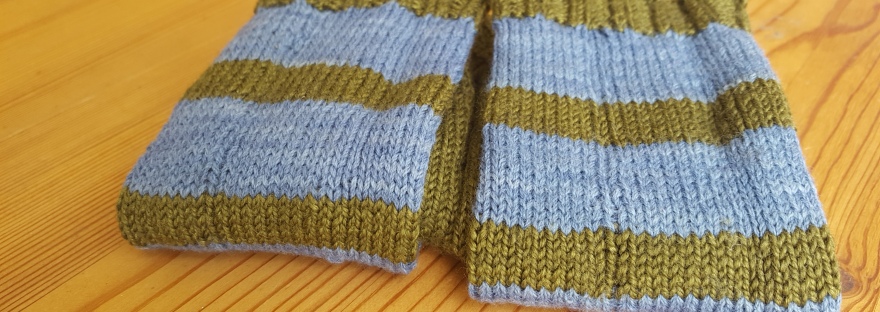

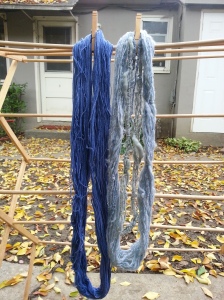



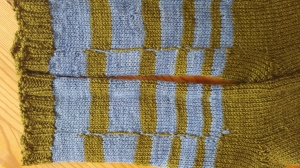
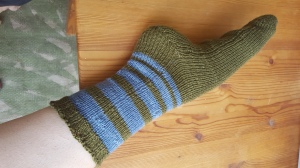


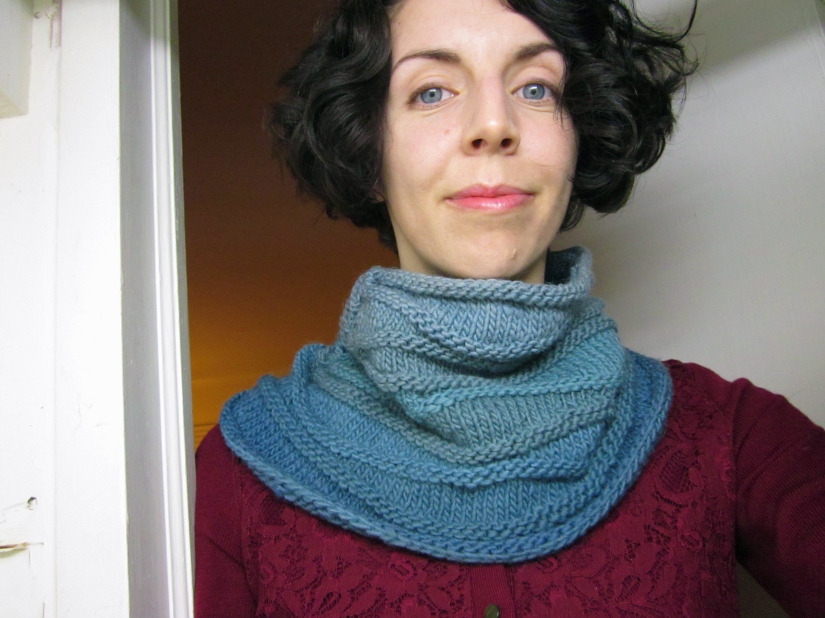




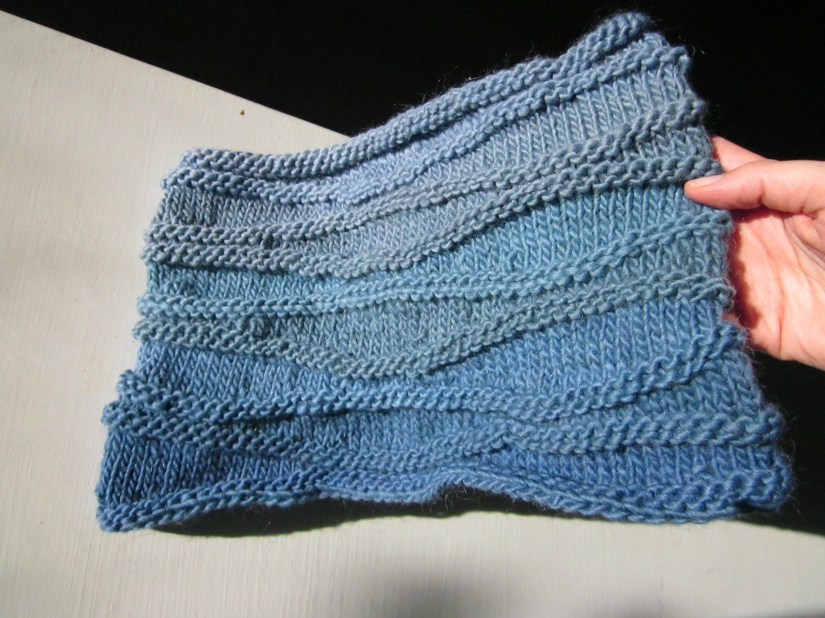





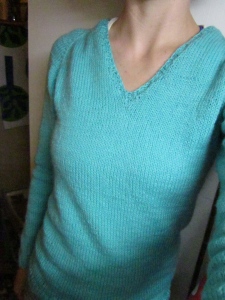





















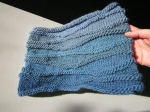






 As you can see, some of our dye lots barely covered the yarn, so we turned them upside down or right side up periodically to avoid unevenness in the color. We let them stay in the dye for 42 hours. I’m sure an even 48 hours would be great, but sleep comes first.
As you can see, some of our dye lots barely covered the yarn, so we turned them upside down or right side up periodically to avoid unevenness in the color. We let them stay in the dye for 42 hours. I’m sure an even 48 hours would be great, but sleep comes first. That’s right—it was a light purple color! At first I was disappointed that all our effort to get blue failed, but in an hour or two it started changing into the blue color you saw in the previous picture.
That’s right—it was a light purple color! At first I was disappointed that all our effort to get blue failed, but in an hour or two it started changing into the blue color you saw in the previous picture.





